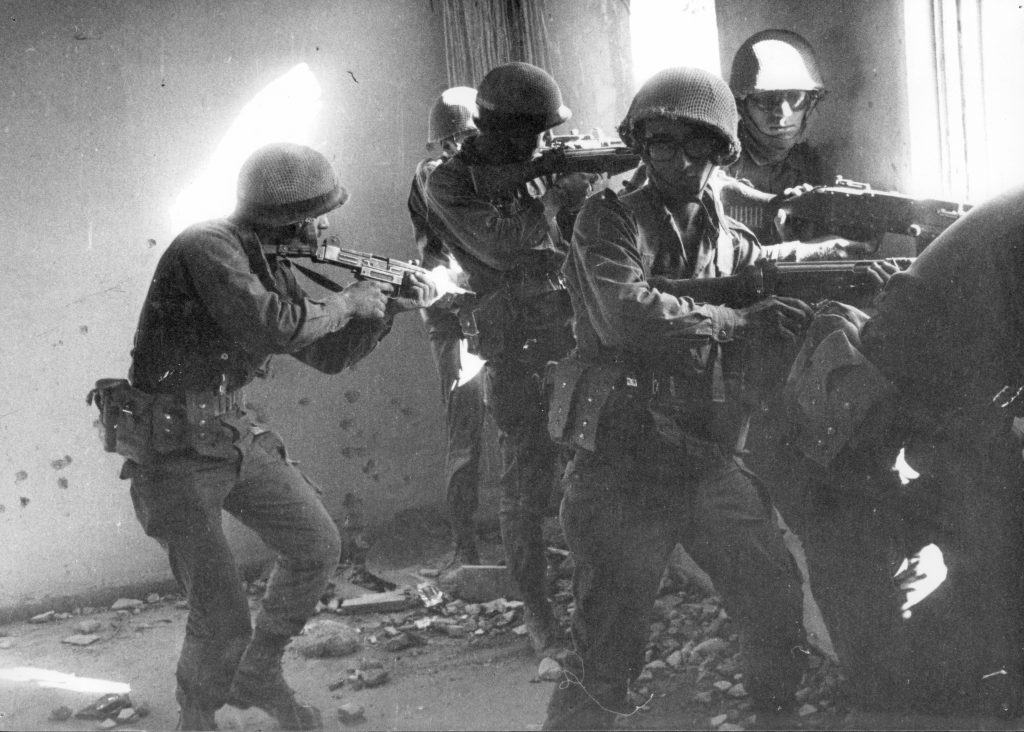When Nathan Fendrich was 38, he traveled to Israel in hopes of a life change — never expecting he would become a combat photographer during the Yom Kippur War.
Now he’s 84, and the photographs Fendrich snapped of the front lines of the Yom Kippur War 45 years ago have been digitized and archived by the National Library of Israel.
Born and raised in Eugene, Fendrich sits in a booth at 5th Street Market wearing a black hat with white stitched letters “US Army & I.D.F.,” as in Israel Defense Forces. He is short, lively and talkative. A few black and white photographs are scattered in front of him, along with yellowed old press credentials.
Fendrich grew up and lived most of his life in Eugene. His family owned a furniture store, Brenner Furniture, where he worked until a difficult divorce when he was 38 drove him to make a change.
“I had come from a tragic divorce,” Fendrich says. “I was bouncing back and forth between depression and anger.”
Throughout his life he always looked for adventure. In 1973, he went to Israel.
Not soon after he arrived, the Yom Kippur war broke out. The war started on Oct. 5, 1973, when an alliance of Arab of states led by Syria and Egypt attacked Israel on two fronts. Fendrich found himself wanting to be involved in any way he could. He wasn’t allowed to join the army because he wasn’t Israeli. Instead, he decided to be a press photographer, despite the fact that he wasn’t particularly great at photography.

Fendrich would load onto the press buses and go to take pictures, going deeper into combat than other photographers by convincing soldiers to let him join their units in the front lines.
“I said, ‘If you guys let me go with you, I will take pictures and send them to you,’” he says. “I used it to get my name around.”
While photographing the front lines, Fendrich suffered a shoulder injury when a mortar shell exploded next to a wall, spraying him with debris.
“I never thought I would be injured and I didn’t care if I got killed, so I took a lot of chances,” Fendrich says.
As the photographer struggled to come to terms with growing depression, an incident changed everything. Following a battle, he was looking at smoking Syrian tanks that had just been shelled.
As he watched, Israeli soldiers pulled a young Syrian soldier, perhaps 18 or 19 years old, out of one of the tanks. He was shaking violently but had not a mark on his body. Fendrich asked what was wrong with the youth and was told he had a concussion from a shell hitting the tank.
The soldiers laid him down very gently on a tarp. The wounded Syrian was saying something, but most of the onlookers couldn’t understand him. One man who spoke Arabic bent down to listen to the dying boy’s words.
“I want to go home,” the man translated when the boy died, just moments later. “I want to go home.”
“It really shook me up,” Fendrich recalls. “I’m wondering what he is doing out here. He should be out at a coffee shop in Damascus with his girl. He shouldn’t be here. That’s when I realized there were issues bigger than me,” he says.
Although Fendrich spent only a few days at a time with the Israeli soldiers, they formed a bond that made a lasting impact on his life.
“The war was my Camelot. Never before, and never since, have I known such camaraderie. The whole army, it fit. We fit.”
Fendrich holds up a black and white photograph of a tank and flips it to the other side, revealing it to be a postcard addressed to KEZI. He explains how he turned his photographs into postcards to escape censorship and smuggle them to different news outlets.
“There was some bad stuff, like seeing a guy die in front of you,” Fendrich says and nods his head slowly. He says he could tell the story for each photograph he took.
The war itself lasted 19 days, and Fendrich photographed on 15 of them. After it ended, he went home and quit the job at the furniture store. He got remarried, raised five kids, and became a self-made historian by devoting his career to teaching U.S. war history in and around Eugene.
Fendrich is also a devoted fan of The Shedd Institute, talking on and on about their past and present productions, which he usually attends multiple times.
For years, the war photos he took sat in his office, unviewed, waiting to be thrown away. Then he met a man, Avi Naiman, at a recent production at The Shedd. When Naiman mentioned he had lived in Israel, Fendrich pulled out a few distorted-wallet size photos to show his pictures of the Yom Kippur war.
“They were collecting dust and he had no way to reach Israel,” Naiman says. Fortunately, Naiman was able to connect Fendrich with the Israeli National Library.

“I was put in touch with the head of the archives of the National Library of Israel and the Israel Defense Forces. Both of them said they would love to have this material,” he says.
The library paid to digitize the photographs. A four-page spread of Fendrich’s work was published in the main Israeli newspaper, Yedioth Aharonoth, on Sept. 13. The small sliver of time Fendrich spent in Israel documenting the war is now being recognized.
Fendrich was happy and excited to hear that his photographs were valued, as he never imagined one of the most instrumental times in his life would ever become relevant again.
“I’m excited,” Fendrich says. “It helps wake people up to what happened.”
